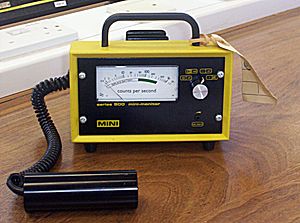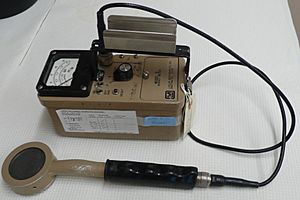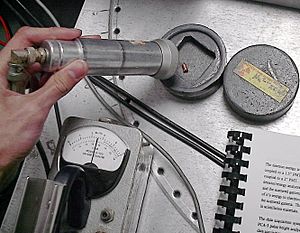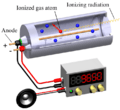Geiger counter facts for kids
A Geiger counter is a special tool that helps us find and measure invisible energy called ionizing radiation. This radiation includes tiny particles like alpha particles and beta particles, and energy waves like gamma rays. People often use Geiger counters as small, handheld devices. They can also be bigger tools used on a table or even built into a permanent system.
Scientists first discovered how these counters work in 1908. Later, in 1928, the main part, called the Geiger-Müller tube, was created. This made Geiger counters very popular because they are strong, reliable, and not too expensive.
Contents
How a Geiger Counter Works
The most important part of a Geiger counter is a special tube called a Geiger-Müller tube. This tube is like a sensor. When radiation enters the tube, it creates a small electrical signal.
The Geiger counter then shows this signal in different ways. It can show "counts per second," which tells you how many times radiation was detected each second. It can also show the "radiation dose rate," which measures how much radiation energy is being absorbed. This is often shown in a unit called the sievert.
Some Geiger counters have old-fashioned dials (analogue displays). Others have digital screens, like a calculator. Many modern ones can even connect to a computer or network to share their readings.
Most Geiger counters also make a clicking sound. The faster the clicks, the more radiation is present. This helps people use the device without always looking at the screen.
Types and Uses of Geiger Counters
Different types of Geiger counters are used for different kinds of radiation.
Detecting Different Radiation Types
- Alpha particles and low-energy beta particles are easily stopped by materials. For these, a special "end window" tube is used. This window is very thin, so the particles can get inside the tube to be detected.
- To find gamma radiation, a tube without a window is often used. Gamma rays can travel through many materials, so they don't need a thin window to enter the tube.
- There are also special Geiger tubes designed to measure neutrons, another type of radiation.
Physical Designs
Geiger counters come in different shapes and sizes:
- Handheld units are common. Some have the detector and all the electronics in one piece. Others have two pieces: a separate detector probe connected by a cable to the main electronics unit.
- A special type for gamma radiation is called a "hot spot" detector. It has the detector tube on the end of a long pole. This design helps keep the person using it far away from areas with high radiation, keeping them safe.
History of the Geiger Counter
The idea behind the Geiger counter started in 1908. A scientist named Hans Geiger developed a way to detect alpha particles. This early method was later used in the Geiger-Müller tube.
Then, in 1928, Hans Geiger and another scientist, Walther Müller, created the sealed Geiger-Müller tube. This new tube was much better because it could detect more types of ionizing radiation. Once this improved tube was available, Geiger counter instruments became practical and could be made quite cheaply for many uses.
Related pages
- Dosimeter - A device used by people to measure the amount of radiation they have received.
- Radioactive decay - The process where much radiation comes from.
Images for kids
-
A Radhound Geiger counter measuring radiation emitted by a tree in Chernobyl
-
G-M pancake detector (right) feeding a microcontroller data-logger (left) sending data to a PC via bluetooth. A radioactive rock was placed on the detector causing the graph (in background) to rise.
See also
 In Spanish: Contador Geiger para niños
In Spanish: Contador Geiger para niños












